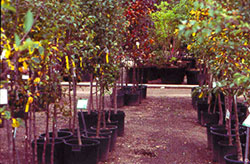Choosing a tree or shrub from a nursery is an art and a science. Small trees and shrubs adapt quicker to planting than larger specimens, especially trees.
What does a healthy young tree look like?

A healthy young tree has a main stem, or trunk, with bark that is undamaged and has not been pruned at the top. The trunk should thicken as it tapers toward the roots.
Depending on the variety, branches should be evenly spaced about eight inches apart around the upper one-third to one-half of the trunk. Avoid trees with branches that have been pruned at the tips.
How are trees and shrubs sold?
Trees and shrubs are sold from nurseries in various ways including bare root, container-grown, and balled and burlapped. Bare root trees and shrubs do not have soil around their roots and are usually less expensive than container grown or balled and burlapped plants. Bare root plants should be purchased and planted when the buds are dormant, usually in March or April.
When can I plant a new tree or shrub?
Container-grown plants are ready to plant when their root systems are developed, and they are not placed on the market until then. Roots should be numerous and preferably not circling inside the container. These plants experience the least shock from transplanting.
Are burlapped trees and shrubs good choices?
Balled and burlapped trees and shrubs are dug either from a nursery field or from the wild. Those dug from the wild are called collected stock. Collected stock generally is less successful than nursery-grown stock because many roots are lost when trees are dug up from the wild. Balled and burlapped plants are only available for sale when they are ready to plant.
For more information, see the following Planttalk Colorado™ video(s).
For more information, see the following Colorado State University Extension fact sheet(s).



